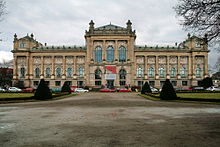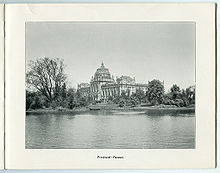- Lower Saxony State Museum
-
The Lower Saxony State Museum (German: Niedersächsisches Landesmuseum Hannover) is a museum in Hanover, Germany. It is located opposite the New City Hall. The museum comprises the State Gallery (Landesgalerie), featuring paintings and sculptures from the Middle Ages to the 20th century, plus departments of archaeology, natural history and ethnology. The museum includes a vivarium with fish, amphibians, reptiles and arthropods.
Contents
History
The museum's forerunner was the Museum of Art and Science (Museum für Kunst und Wissenschaft), inaugurated in 1856 in the presence of George V of Hanover.[1] Based in the present-day Hanover Künstlerhaus, it was later renamed the Museum of the Province of Hanover or Provincial Museum. The museum soon ran out of space for its art collections, prompting the construction of the current building, on the edge of the Maschpark, in 1902. It was designed by Hubert Stier in a Neorenaissance style.[2] The building's relief frieze, titled "Key Moments in the Evolution of Humanity" (Hauptmomente in der Entwicklung der Menschheit), was created by the Hanoverian artist Georg Herting in partnership with Karl Gundelach and Georg Küsthardt.
It was renamed the State Museum in 1933, and finally the Lower Saxony State Museum of Hanover in 1950.
The cupola above the central risalit was destroyed by Allied bombs during the war. Extensive renovations and modernisations were carried out in the building's interior from 1995 to 2000. The reopening took place on 13 May as part of Expo 2000.
Collections
 Lovis Corinth, Paddel-Petermannchen (his nickname for his wife).
Lovis Corinth, Paddel-Petermannchen (his nickname for his wife).
State Gallery
The State Gallery features art from the 11th to the 20th centuries. The collection includes German and Italian works from the Renaissance and the Baroque, 17th century Flemish and Dutch paintings, Danish paintings from the 19th and 20th centuries (e.g. Constantin Hansen), and a print room featuring old German masters, Dutch drawings, 19th century printworks, and drawings by German Impressionists. Some of the best-known artists include Rembrandt, Rubens and Albrecht Dürer.
The gallery's other strengths include German and French Impressionist paintings, works by Max Liebermann, Lovis Corinth and Max Slevogt, and major works from members of the Künstlerkolonie Worpswede group, such as Bernhard Hoetger, Fritz Overbeck, Otto Modersohn and Paula Modersohn-Becker. Caspar David Friedrich's four-piece Tageszeitenzyklus (The Times of Day) is the only complete such series by Friedrich in a single museum.[3]
- 'Der Tageszeitenzyklus' by Caspar David Friedrich
Natural history
The natural history department features, among other things, a life-sized model of a dinosaur, and a vivarium with more than 2,000 native and exotic fish, amphibians and reptiles. The model dinosaur, an iguanodon, is not an accurate reconstruction by the standards of modern palaeontology, but has been integrated into an exhibition which shows the changing reconstructions of this species over time. The department also has zoological, botanical, anthropological, geographical and geological exhibits on the primeval history of Lower Saxony's regions, including the Harz mountains, the heathlands, and the North Sea coast.
Archaeology
 The Gold Lunula of Schulenburg, discovered 1911.
The Gold Lunula of Schulenburg, discovered 1911.
The Lower Saxony State Museum has a major archaeological collection, containing some unique finds. With over a million artefacts showing the economic and technological development of human settlement, the display covers almost 500,000 years of history, spanning the Early Stone Age to the late Middle Ages, from the early hunter-gatherer cultures to the blossoming of metropolitan life.[4] The archaeology department is supported by the Lower Saxony State Society of Prehistory (Niedersächsischer Landesverein für Urgeschichte), and its working group "Arbeitskreis... STEINZEIT".[5][6]
Ethnology
The ethnological collection is among the oldest in German-speaking territory, and includes around 20,000 artworks and everyday artefacts from all parts of the world. A wide range of religions and cultures in America, Africa, Oceania and Asia is displayed through the findings of explorers and ethnologists.
Special exhibitions and facilities
The Lower Saxony State Museum regularly hosts temporary exhibitions on changing themes. The museum also offers its own pest control facility (a nitrogen chamber) for infested artworks and artefacts, for use by private citizens.[7]
Further reading
- Heide Grape-Albers (editor): Das Niedersächsische Landesmuseum Hannover 2002. 150 Jahre Museum in Hannover – 100 Jahre Gebäude am Maschpark. Festschrift commemorating the 100th anniversary of the Maschpark building. Lower Saxony State Museum, Hanover, 2002. ISBN 3-929444-29-1.
- Frühes Gold. Ur- und Frühgeschichtliche Goldfunde aus Niedersachsen. Lower Saxony State Museum, Isensee, Oldenburg, 2003. ISBN 3-89995-066-6.
External links
- Official website (German)
Notes
- ^ Das Künstlerhaus Press service of the city of Hanover. (German)
- ^ Hannover - Niedersächsisches Landesmuseum "Stadthistorie Hannover". (German)
- ^ Wuchernde Dingfülle Johanna di Blasi, Die Welt, 2 November 2009. Retrieved 12 September 2010. (German)
- ^ Archäologie The archaeology department. (German)
- ^ Satzung des Niedersächsischen Landesvereins für Urgeschichte e. V. The society's constitution. (German)
- ^ Niedersächsischer Landesverein für Urgeschichte e.V. (German)
- ^ Effektive Schädlingsbekämpfung an Kunst- und Kulturgütern About the nitrogen chamber. (German)
- This article incorporates information from this version of the equivalent article on the German Wikipedia.
Categories:- Museums in Lower Saxony
- Art museums and galleries in Germany
- Hanover
- History of Lower Saxony
- Culture of Lower Saxony
- Museums established in 1856
- Natural history museums in Germany
- Archaeology museums in Germany
- Ethnographic museums in Germany
Wikimedia Foundation. 2010.






